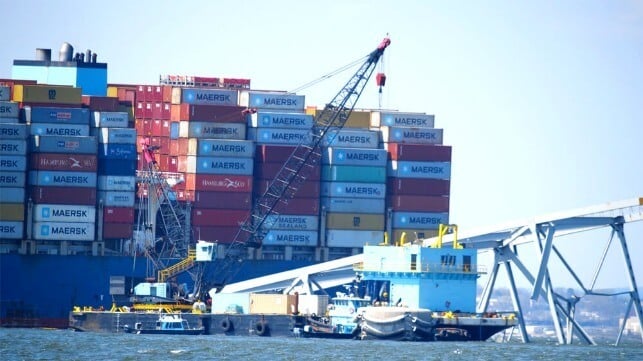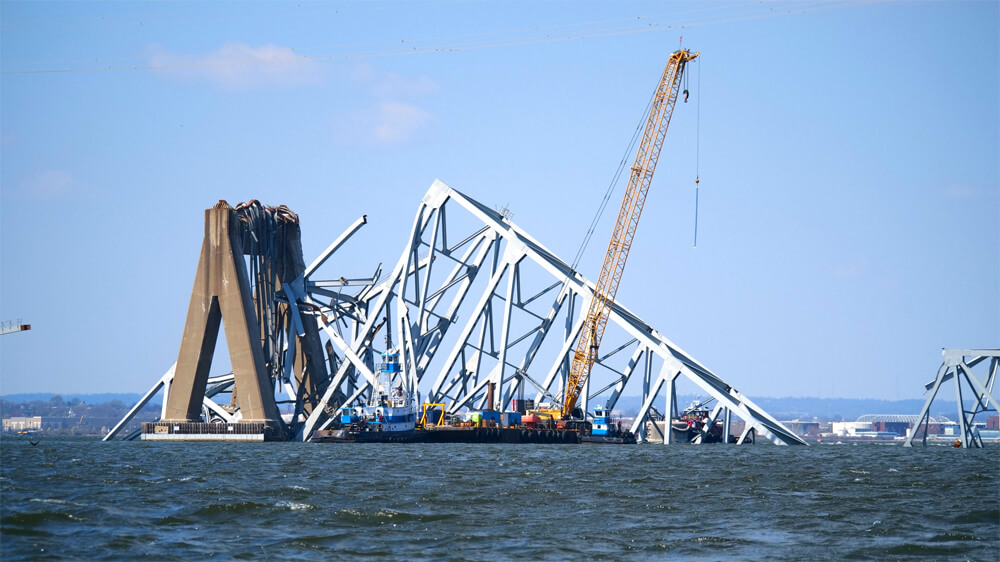Cranes and Equipment Reach Baltimore as Salvage Plan is Developed

Equipment is beginning to arrive in Baltimore and is being pre-positioned at critical points near the wreckage of the Francis Scott Key Bride and the stranded containership Dali in preparation for one of the largest salvage operations ever undertaken in the United States. Working with the newly formed Unified Command established by the U.S. Coast Guard, federal, state, and city entities, along with private enterprise are working to formulate the salvage plan.
Speaking to reporters at a briefing on Friday, Rear Admiral Shannon Gilreath said teams of engineers from the Army Corps of Engineers along with the Navy and USCG and the private sector are all assessing the situation and working on a plan. One of the first goals is determining how to break up the bridge into manageable pieces that they can lift and remove on barges.
“Before we can actually engage in lifting, we have to figure out how to cut the bridge into right size pieces,” said Admiral Gilreath.
After touring the site and the cranes arriving from the U.S. Navy, Governor Wes Moore highlighted that one of the biggest challenges is the section of the bridge sitting on the Dali. He notes it weighs between some 3,000 to 4,000 tons. He said they would have to cut up the truss into sections in “a safe and responsible way.”
One of the key elements of the private sector already gearing up to participate in the efforts is the dredging industry which will be vital to ensuring the waterway is again passable for ships. William Doyle, Chief Executive Officer of the Dredging Contractors of America, highlighted the critical contribution coming from his industry.
Speaking to The Maritime Executive, Doyle said, “About 66-75 percent of the channel is not blocked by the ship. Therefore, clearing the channel of the debris will probably be the first step and given the most attention in order to open the channel as soon as possible.”

Three cranes arrived and a fourth will be in place by early next week with other assets also being mobilized
First to arrive overnight was the Chesapeake, a 1,000-ton lift capacity derrick barge brought in by the U.S. Navy. It was followed today by the Ferrell, a 200-ton lift capacity revolving crane barge, and the Oyster Bay, a 150-ton lift capacity crane barge. In addition, by early next week, the Navy reports an additional 400-ton lift capacity barge is also due to arrive, with all the barges contracted through Naval Sea Systems Command. The Navy’s Supervisor of Salvage and Diving will be overseeing the operation to remove the submerged portions of the bridge. The Navy highlights that an additional 12 cranes and support vessels are currently being mobilized.
Governor Moore emphasizing the scope of the upcoming operation reported that seven floating cranes, 10 tugs, nine barges, eight salvage vessels, and five Coast Guard vessels are all assigned to the project. He said all the assets would be arriving as quickly as possible.

that matters most
Get the latest maritime news delivered to your inbox daily.
“To go out there and see it up close, you realize just how daunting a task this is,” the Governor told reporters. “You realize how difficult the work is ahead of us.”
The governor said there are clear priorities ahead with the first being to bring closure to the families of the workers who perished during the bridge collapse. His second priority is to clear the channel and open the port as quickly as possible. He said the health of the Maryland economy and the national economy depends on opening the port. He is also focused on taking care of everyone and the business impacted, and finally to get the bridge rebuilt.
